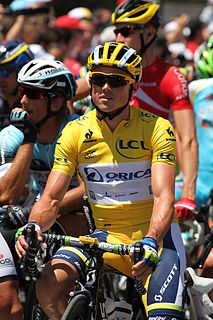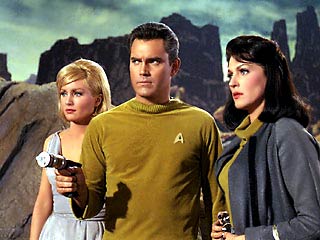
Stop motion is an animated-film making technique in which objects are physically manipulated in small increments between individually photographed frames so that they will appear to exhibit independent motion when the series of frames is played back as a fast sequence. Dolls with movable joints or clay figures are often used in stop motion for their ease of repositioning. Stop-motion animation using plasticine figures is called clay animation or "clay-mation". Not all stop motion, however, requires figures or models: stop-motion films can also be made using humans, household appliances, and other objects, usually for comedic effect. Stop motion using humans is sometimes referred to as pixilation or pixilate animation.

High-visibility clothing, sometimes known as "hi-viz", is any clothing worn that has highly reflective properties or a colour that is easily discernible from any background. Most industrial employers require it as a type of personal protective equipment (PPE). Yellow waistcoats worn by emergency services are a common example. Occupational wearers of clothing with high-visibility features include railway and highway workers, airport workers, or other places where workers are near moving vehicles or in dark areas. Some cyclists wear high-visibility clothing when riding amongst motor vehicles. Hunters may be required to wear designated high-visibility clothing to prevent accidental shooting.

The general classification is the most important classification, the one by which the winner of the Tour de France is determined. Since 1919, the leader of the general classification wears the yellow jersey.

Scott Weinger is an American actor, voice actor, writer and producer, best known as the voice of the title character in Disney's Aladdin. Weinger reprised the role in the two direct-to-video sequels, the television series of the same name, and the Kingdom Hearts and Disney Infinity video game series. He is also known for playing Steve Hale on the ABC sitcom Full House and its Netflix sequel Fuller House. He is also a writer and producer for television, including for ABC's Galavant and Black-ish. He was a co-executive producer of ABC's The Muppets.

Rudolph the Red-Nosed Reindeer is a 1964 Christmas stop motion animated television special produced by Videocraft International, Ltd. and currently distributed by Universal Television. It first aired Sunday, December 6, 1964, on the NBC television network in the United States, and was sponsored by General Electric under the umbrella title of The General Electric Fantasy Hour. The special was based on the Johnny Marks song "Rudolph the Red-Nosed Reindeer" which was itself based on the poem of the same name written in 1939 by Marks' brother-in-law, Robert L. May. Since 1972, the special has aired on CBS; the network unveiled a high-definition, digitally remastered version of the program in 2005. As with A Charlie Brown Christmas and How the Grinch Stole Christmas, Rudolph no longer airs just once annually, but several times during the Christmas and holiday season on CBS. Unlike other holiday specials that also air on several cable channels, Rudolph airs only on CBS. It has been telecast every year since 1964, making it the longest continuously running Christmas TV special in history. 2014 marked the 50th anniversary of the television special and a series of postage stamps featuring Rudolph were issued by the United States Postal Service on November 6, 2014.
BB3B was an animated UK children's television series produced by Tell-Tale Productions in 2005. The entire series consists of thirteen episodes of twenty minutes each. It is shown on CBBC in the UK and ABC Kids in Australia. It first went on air in 2005. It was voted the best section of Dick and Dom in da Bungalow and Smile by viewers in two separate polls.

Play School is an Australian educational television show for children produced by the Australian Broadcasting Corporation. It is the longest running children's show in Australia, and the second longest running children's show worldwide, after Blue Peter.

Star Trek uniforms are costumes worn by actors portraying personnel from the fictitious organization Starfleet in the Star Trek science fiction franchise. Costume design often changed between various television series and films, especially those representing different time periods, both for appearance and comfort. Deliberately mixing styles of uniforms from the various series was occasionally used to enhance the sense of time travel or alternative universes.
Pittsburgh Yellow Jackets was the name of two separate ice hockey teams based in Pittsburgh, Pennsylvania. The original team played from 1915–1925. They evolved from being an amateur to a semi-pro team and are one of the earliest sports organizations in Pittsburgh, Pennsylvania. The Yellow Jackets played primarily in the United States Amateur Hockey Association (USAHA). After winning the USAHA Championship in 1924 and 1925, the Yellow Jackets were sold to attorney James Callahan and soon became the Pittsburgh Pirates of the National Hockey League. However, after the demise of the Pirates in 1930, a second club, debuted in the IHL as a professional entity, before reverting to an amateur club in 1934. The team would finish its run in the EAHL, before finally folding in 1937.

The Ferals was an Australian children's comedy television series which screened on the ABC from 1994 to 1995. It was created by Wendy Gray and Claire Henderson and featured a mixture of people and animal puppets known as the "Ferals." It was lauded for its irreverent humour and distinctive characters, some of which featured on other ABC programming. Garth Frost was responsible for the puppet design.
Bodgies and widgies refer to a youth subculture that existed in Australia and New Zealand in the 1950s, similar to the rocker culture in the UK or Greaser culture in the United States. Most bodgies rode motorbikes but some had cars, many of which were hotted-up e.g. mag wheels, hot dog muffler, etc.
The Uniform of the Union Army was widely varied and, due to limitations on supply of wool and other materials, based on availability and cost of materials during the United States Civil War.

Angelina Ballerina: The Next Steps is a British musical CGI animated television series that premiered on 5 September 2009, on PBS Kids in the United States. It is a continuation of the Angelina Ballerina television series from 2002–2006; both series are in turn based on the Angelina Ballerina series of children's books by Katharine Holabird, the author and Helen Craig, the illustrator. The Next Steps is different from the first TV series as it uses CGI animation. This series sees eight-year-old Angelina and her family move to the other side of Chipping Cheddar to attend a performing arts school called Camembert Academy. It features the debut of Ms. Mimi, Angelina's new teacher and new friends like Viki, Marco, Gracie, and A.Z., as well as her best friend Alice who joins Camembert Academy. It features songs with music by Mark Sayer-Wade and lyrics by Judy Rothman and footage from host Moira Quirk. Richard M. Sherman is the music director of the series.
"Smokin' Hot" is the 14th episode of the fourth season of the American comedy-drama series, Ugly Betty, and the 79th episode overall. It originally aired on ABC in the United States on February 10, 2010.
The 1999 Gator Bowl was a post-season American college football bowl game between the Notre Dame Fighting Irish and the Georgia Tech Yellow Jackets played at Alltel Stadium in Jacksonville, Florida, on January 1, 1999. For sponsorship reasons, the game was officially named the 1999 Toyota Gator Bowl. The game was the final contest of the 1998 NCAA Division I-A football season for both teams, the 54th edition of the annual Gator Bowl game, and ended in a 35–28 victory for Georgia Tech.

The Philadelphia Yellow Jackets were a professional indoor football team and a member of the American Indoor Football league that played half a season in 2016 before folding due to financial issues.

Noddy, Toyland Detective is a computer animated series featuring the character Noddy created by Enid Blyton. The series was produced by DreamWorks Animation Television and Gaumont Animation. Commissioned by France Télévisions, it premiered on March 26, 2016, on the platform Zouzous, and aired on France 5, on April 2, 2016.

The 2017 Georgia Tech Yellow Jackets football team represented the Georgia Institute of Technology during the 2017 NCAA Division I FBS football season. The Yellow Jackets were led by tenth-year head coach Paul Johnson and played their home games at Bobby Dodd Stadium. They competed as a member of the Coastal Division in the Atlantic Coast Conference. They finished the season 5–6, 4–4 in ACC play to finish in third place in the Coastal Division.














